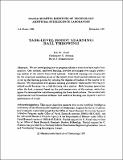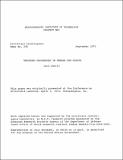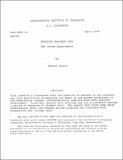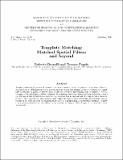Browsing AI Memos (1959 - 2004) by Title
Now showing items 1085-1104 of 1217
-
Tactile Recognition and Localization Using Object Models: The Case of Polyhedra on a Plane
(1983-03-01)This paper discusses how data from multiple tactile sensors may be used to identify and locate one object, from among a set of known objects. We use only local information from sensors: (1) the position of contact ... -
Task and Object Learning in Visual Recognition
(1991-01-01)Human performance in object recognition changes with practice, even in the absence of feedback to the subject. The nature of the change can reveal important properties of the process of recognition. We report an ... -
Task-Level Robot Learning: Ball Throwing
(1987-12-01)We are investigating how to program robots so that they learn tasks from practice. One method, task-level learning, provides advantages over simply perfecting models of the robot's lower level systems. Task-level ... -
Taxonomic Syntax for First-Order Inference
(1989-06-01)Most knowledge representation languages are based on classes and taxonomic relationships between classes. Taxonomic hierarchies without defaults or exceptions are semantically equivalent to a collection of formulas ... -
Teacher's Guide for Computational Models of Animal Behavior
(1977-04-01)This is an experimental curriculum unit which suggests how the computational perspective can be integrated into a subject such as elementary school biology. In order to illustrate the interplay of computer and non-computer ... -
Teaching Children Thinking
(1971-10-01)This paper is dedicated to the hope that someone with power to act will one day see that contemporary research on education is like the following experiment by a nineteenth century engineer who worked to demonstrate that ... -
Teaching Children to be Mathematicians vs. Teaching About Mathematics
(1971-07-01)Being a mathematician is no more definable as 'knowing' a set of mathematical facts than being a poet is definable as knowing a set of linguistic facts. Some modern math ed reformers will give this statement a too easy ... -
Teaching of Procedures-Progress Report
(1972-10-01)The idea of building a programmer is very seductive in that it holds the promise of massive bootstrapping and thus ties in with many ideas about learning and teaching. I will avoid going into those issues here. It is ... -
Teaching Procedures in Humans and Robots
(1970-09-01)Analysis of the structure of procedures is central to the foundations of problem soling. In this paper we explore three principle means for teaching procedures: telling, canned loops, and procedural abstraction. The ... -
Teaching Teachers LOGO: The Lesley Experiments
(1976-04-01)This research is concerned with the question of whether or not teachers who lack specialized backgrounds can adapt to and become proficient in the technically complex, philosophically sophisticated LOGO learning ... -
Teaching the Computer to Add: An Example of Problem-Solving in an Anthropomorphic Computer Culture
(1976-12-01)Computers open up new ways to think about knowledge and learning. Learning computer science should draw upon and feed these new approaches. In a previous paper called "Leading a Child to a Computer Culture" I discuss ... -
Television Camera-To-Computer Adapter: PDP-6 Device 770
(1965-01-01)The TVA (Television Adaptor) is a data-input device just completed. Any standard Closed-Circuit Television Camera can be connected to the PDP-6, without modification, by a single BNC connector. Then a simple program can ... -
Template Matching: Matched Spatial Filters and Beyond
(1995-10-01)Template matching by means of cross-correlation is common practice in pattern recognition. However, its sensitivity to deformations of the pattern and the broad and unsharp peaks it produces are significant drawbacks. This ... -
Tense, Aspect and the Cognitive Representation of Time
(1984-12-01)This paper explores the relationships between a computation theory of temporal representation (as developed by James Allen) and a formal linguistic theory of tense (as developed by Norbert Hornstein) and aspect. It ... -
The Text-Justifier TJ6
(1970-06-01)This memo describes the TJ6 type justifying program, which can be used in the production of memos, such as this one. In addition, Appendices 1, 2, and 3 of this memo contain related information about TECO, the "Selectric" ... -
The Text-Justifier TJ6
(1976-05-01)This memo, intended as both a reference and user's manual describes the text-justifying program TJ6, which compiles a neat output document from a sloppy input manuscript. TJ6 can justify and fill text; automatically ... -
A Theoretical Analysis of Electrical Properties of Spines
(1983-04-01)The electrical properties of a cortical (spiny) pyramidal cell were analyzed on the basis of passive cable theory from measurements made on histological material (Koch, Poggio & Torre 1982). The basis of this analysis ... -
A Theoretical Analysis of the Electrical Properties of a X-Cell in the Cat's LGN
(1984-03-01)Electron microscope studies of relay cells in the lateral geniculate nucleus of the CAT have shown that the retinal input of X-cells is associated with a special synaptic circuitry, termed the spine-triad complex. The ... -
Theories, Pre-Theories and Finite State Transformations on Trees
(1971-05-01)The closure of an algebra is defined as a generalization of the semigroup of a finite automation. Pretheories are defined as a subclass of the closed algebras, and the relationship between pretheories and the algebraic ... -
A Theory of Computer Instructions
(1965-09-01)This paper has arisen from an attempt to determine the nature of computer instructions from a viewpoint of general function and set theory. Mathematical machines, however the term is understood, are not adequate models for ...



















